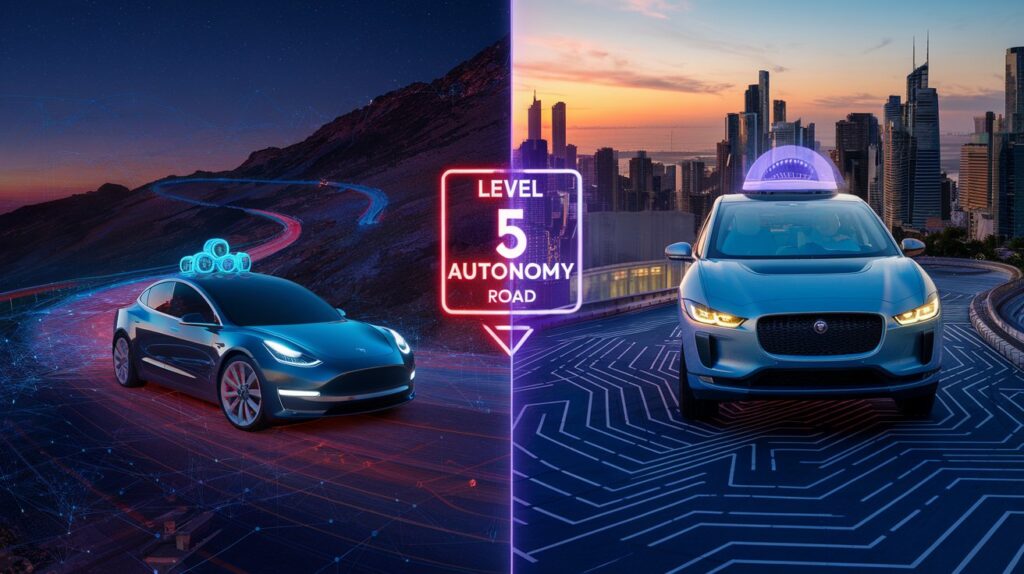Introduction
The race to achieve Level 5 autonomy—a self-driving system capable of handling any driving scenario without human intervention—has captivated the automotive and tech industries. Two frontrunners, Tesla and Waymo, are pursuing radically different strategies to reach this milestone. Tesla’s Full Self-Driving (FSD) Version 12 relies on neural networks and a camera-first approach, while Waymo’s Driver employs LiDAR, high-definition maps, and geofenced operations. But which strategy is closer to unlocking true driverless freedom? Let’s dive into the strengths, limitations, and philosophies of each system to find out.
The Contenders: A Tale of Two Philosophies
1. Tesla FSD V12: Vision-Centric Ambition
Tesla’s FSD V12 represents a bold bet on artificial intelligence and camera-based perception. Unlike previous iterations, V12 leans almost entirely on neural networks trained by billions of real-world driving miles from Tesla’s global fleet.
Key Features:
- End-to-End Neural Networks: FSD V12 processes raw camera data through a single AI model, mimicking human decision-making.
- No HD Maps: Relies on real-time visual data rather than pre-mapped environments.
- Scalability: Designed to work anywhere, from highways to dense urban streets.
Strengths:
- Adaptability: Excels in unpredictable scenarios (e.g., construction zones, erratic pedestrians).
- Continuous Learning: Tesla’s fleet collects ~160 billion miles of data annually, refining the system.
- Consumer Accessibility: Available to owners as a $12,000 upgrade (beta mode).
Limitations:
- Camera-Only Skepticism: Critics argue LiDAR or radar redundancy is critical for safety.
- Geographic Agnosticism: Struggles in regions with poor signage or extreme weather.
- Regulatory Hurdles: Still classified as a Level 2 system, requiring driver supervision.
2. Waymo Driver: Precision Through Sensor Fusion
Waymo, a Alphabet subsidiary, prioritizes safety and predictability with a sensor-heavy, geofenced approach. Its fifth-generation Driver combines LiDAR, radar, cameras, and proprietary maps to operate robotaxis in cities like San Francisco and Phoenix.
Key Features:
- LiDAR-Centric Design: Creates 360° 3D maps for precise object detection.
- HD Mapping: Pre-scans operational areas to centimeter-level accuracy.
- Rideshare Focus: Deployed commercially via Waymo One, offering driverless rides.
Strengths:
- Proven Safety: Boasts a lower disengagement rate than human drivers in geofenced zones.
- Regulatory Progress: Holds permits for fully driverless operations in multiple states.
- Consistency: Thrives in mapped environments with minimal surprises.
Limitations:
- Scalability Challenges: Expanding to new cities requires costly re-mapping.
- Weather Dependency: Struggles in heavy rain or snow without infrastructure updates.
- Niche Use Case: Limited to specific urban corridors, not cross-country travel.
Head-to-Head: Critical Metrics for Level 5 Readiness
1. Handling Edge Cases
- Tesla FSD V12: Trained on global data, it navigates rare scenarios (e.g., jaywalking, unmapped roads) but occasionally hesitates or requires human intervention.
- Waymo Driver: Avoids edge cases by restricting operations to mapped areas. Rarely ventures into uncharted territory.
Verdict: Tesla’s adaptability gives it an edge, but Waymo’s caution minimizes risks.
2. Safety and Reliability
- Tesla: NHTSA reports cite concerns about phantom braking and misinterpretation of static objects.
- Waymo: California DMV data shows 0.09 disengagements per 1,000 miles—far safer than human drivers.
Verdict: Waymo’s meticulous approach wins on safety metrics.
3. Scalability
- Tesla: No geofencing means FSD could theoretically scale globally overnight—if regulators approve.
- Waymo: Each new city requires months of mapping and regulatory lobbying.
Verdict: Tesla’s vision is more scalable long-term.
4. Regulatory Approval
- Tesla: Still years away from Level 5 certification due to supervision requirements.
- Waymo: Already operates fully driverless vehicles in select cities.
Verdict: Waymo leads in regulatory trust.
The Path to Level 5: Challenges Ahead
Tesla’s Hurdles
- Validation: Proving camera-only systems match LiDAR’s safety in all conditions.
- Human Factor: Eliminating the need for driver oversight.
- Global Regulations: Navigating disparate international laws.
Waymo’s Hurdles
- Cost: LiDAR and HD mapping make scaling prohibitively expensive.
- Weather: Expanding to regions with snow or monsoons.
- Public Trust: Overcoming skepticism after rare high-profile incidents.
Expert Opinions: Split Perspectives
- AI Researchers: Praise Tesla’s data-driven approach but question its sensor limitations.
- Automotive Engineers: Favor Waymo’s redundancy but acknowledge its scalability issues.
- Elon Musk: Claims FSD will achieve Level 5 by 2024 “with high certainty.”
- Waymo CEO Tekedra Mawakana: Emphasizes incremental expansion: “Safety can’t be rushed.”
Conclusion: Who’s Closer to Level 5?
The answer depends on how you define “closer.” Waymo has already delivered true autonomy—but only in carefully curated bubbles. Tesla aims for universal self-driving, but its journey hinges on solving AI’s “last 1%” of edge cases and regulatory buy-in.
Short-Term: Waymo’s geofenced robotaxis are closer to Level 4/5 in their domains.
Long-Term: Tesla’s scalable, data-hungry AI might ultimately win the marathon—if it can bridge today’s gaps.
For now, the race remains neck-and-neck, proving that the road to Level 5 is anything but a straight line.
Final Word: Whether you’re Team Vision or Team LiDAR, both companies are accelerating us toward a driverless future. The real winner? Consumers eager for safer, smarter roads.
Stay tuned for updates—the finish line inches closer every day.

